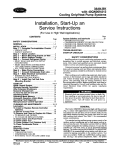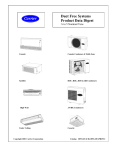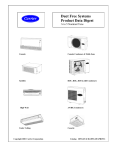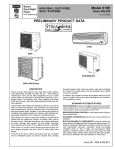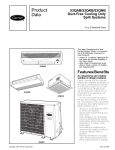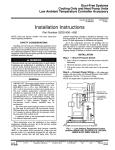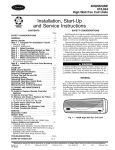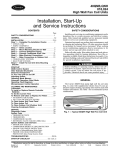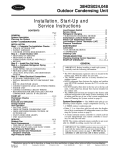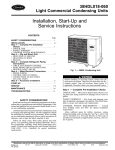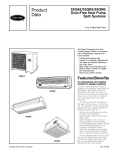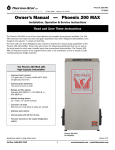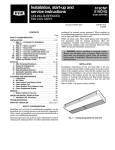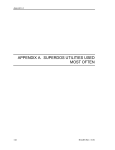Download Carrier 38BK-012 Specifications
Transcript
38AN,BK with 40QN009,012 Cooling Only/Heat Pump Systems Installation, Start-Up an Service Instructions (For Use in High Wall Applications) CONTENTS Page SAFETY CONSIDERATIONS . . . . . . . . . . . . . . . . . . . 1 GENERAL . . . . . . . . . . . . . . . . . . . . . . . . . . . . . . . . . . 1,2 INSTALLATION . . . . . . . . . . . . . . . . . . . . . . . . . . . . . 2-13 Step 1 − Complete Pre-Installation Checks . . . . 2 • UNPACK UNIT • INSPECT SHIPMENT Step 2 − Select Location . . . . . . . . . . . . . . . . . . . . . 2 Step 3 − Mount Mounting Bracket on Wall . . . . 3 Step 4 − Mount Outdoor Section . . . . . . . . . . . . . 9 Step 5 − Connect Refrigerant Piping . . . . . . . . 10 • RIGHT REAR AND BOTTOM PIPING CONNECTIONS • RIGHT SIDE PIPING CONNECTIONS • LEFT SIDE PIPING CONNECTIONS • ALL TYPES PIPING CONNECTIONS Step 6 − Make Piping Connections . . . . . . . . . . 10 Step 7 − Connect Condensate Drain Line . . . . 11 Step 8 − Make Electrical Connections . . . . . . . 11 • INDOOR SECTION WIRING • OUTDOOR SECTION WIRING Step 9 − Install Fan Coil Unit Onto Mounting Bracket . . . . . . . . . . . . . . . . . . . . . . . . . 13 START-UP . . . . . . . . . . . . . . . . . . . . . . . . . . . . . . . . 14-17 40QN Control System . . . . . . . . . . . . . . . . . . . . . . . 14 Wireless Remote Controllers . . . . . . . . . . . . . . . . 14 After Extended Shutdowns . . . . . . . . . . . . . . . . . . 14 Seasonal Changeovers . . . . . . . . . . . . . . . . . . . . . . 14 To Turn the Unit On and Off . . . . . . . . . . . . . . . . . 14 Adjusting Airflow . . . . . . . . . . . . . . . . . . . . . . . . . . . 14 Operating Mode Memory . . . . . . . . . . . . . . . . . . . . 14 Automatic Operation (Auto) Mode . . . . . . . . . . . . 14 Operating Fault Diagnosis . . . . . . . . . . . . . . . . . . . 15 Microprocessor Control Operation . . . . . . . . . . . 15 CLEANING AND MAINTENANCE . . . . . . . . . . . . 18-19 Lubrication . . . . . . . . . . . . . . . . . . . . . . . . . . . . . . . . . 18 To Install or Replace Remote Controller Batteries . . . . . . . . . . . . . . . . . . . . . . . . . . . . . . . . . 18 To Set the Current Time . . . . . . . . . . . . . . . . . . . . . 18 To Remove and Clean or Replace Air Filters . . 18 • TO REMOVE AIR FILTERS • TO CLEAN OR REPLACE FILTERS To Clean Indoor Unit Front Panel . . . . . . . . . . . . 19 To Clean Indoor Coil . . . . . . . . . . . . . . . . . . . . . . . . 19 To Clean Outdoor Coil (Outdoor Unit) . . . . . . . . 19 To Clean Condensate Drains . . . . . . . . . . . . . . . . . 19 SERVICE . . . . . . . . . . . . . . . . . . . . . . . . . . . . . . . . . . . 20 Diagnostic Codes . . . . . . . . . . . . . . . . . . . . . . . . . . . 20 System Tests . . . . . . . . . . . . . . . . . . . . . . . . . . . . . . . 20 • THERMISTOR TESTS • COMPRESSOR FAILURE • REVERSING VALVE FAILURE (38BK Only) Page System Safeties and Interlocks . . . . . . . . . . . . . . 20 • INDOOR FAN FAILURE • COMPRESSOR SHORT-CYCLING PROTECTION • INDOOR COIL FREEZE PROTECTION • INDOOR COIL HIGH-TEMPERATURE PROTECTION TROUBLESHOOTING . . . . . . . . . . . . . . . . . . . . . . 20-27 START-UP CHECKLIST . . . . . . . . . . . . . . . CL-1, CL-2 SAFETY CONSIDERATIONS Installing and servicing air-conditioning equipment can be hazardous due to system pressure and electrical components. Only trained and qualified service personnel should install or service air-conditioning equipment. Untrained personnel can perform basic maintenance functions such as cleaning coils and filters and replacing filters. All other operations should be performed by trained service personnel. When working on air conditioning equipment, observe precautions in the literature and on tags and labels attached to unit. Follow all safety codes. Wear safety glasses and work gloves. Use quenching cloth for brazing operations. Have fire extinguisher available. Before installation, read these instructions thoroughly. Consult local building codes and National Electrical Code (NEC) for special installation requirements. Electrical shock can cause personal injury or death. Before installing or servicing system, be sure to turn off main power to system. There may be more than one disconnect switch. Turn off indoor fan coil power as applicable. GENERAL The Carrier 40QNH012 heat pump high wall fan coil unit (Fig. 1) comes with supplemental electric heat (40QNE009 heat pump fan coil unit does not have electric heat). If your application requires heating, heat pump units must be used both outdoors and indoors. See Table 1 for recommended system combinations. The matched cooling and heat pump systems consist of an outdoor section (condensing unit or heat pump) and an indoor section (fan coil). The outdoor section (38AN or 38BK) is installed alongside the building structure. It can also be installed on a flat roof, deck, or on an apartment building balcony. The indoor section (40QNB009,012 or 40QNE009, 40QNH012) is mounted high on an interior wall that is convenient for piping connection to the outdoor section. Two sizes are available: 9,000 and 12,000 Btuh cooling capacities. See Fig. 1 for system components, Table 1 for system Manufacturer reserves the right to discontinue, or change at any time, specifications or designs without notice and without incurring obligations. Book 1 4 PC 111 Catalog No. 533-848 Printed in U.S.A. Form 38A,B/40Q-1SI Pg 1 5-99 Replaces: 53AN,BK-1SI Tab 3e 2f combinations, and Table 2 for application range. Refer to this manual for proper installation of the complete system. Refer to Table 1 to make sure the correct indoor unit is installed with the correct outdoor unit. Be sure the unit will be operated within the application guidelines shown in Table 2. When installing the 38AN or 38BK unit, it is important to note that for cooling operation when the outdoor air temperature is below 55 F, it is necessary to equip the outdoor unit with the low-ambient accessory. To install this unit you will need: 1 — 40QNB or 40QNE/H Fan Coil unit with standard wireless remote controller and indoor unit wire 1 — 38AN or 38BK Outdoor Unit 1 — Low-Ambient Kit (if required for your application) INSTALLATION Step 1 — Complete Pre-Installation Checks UNPACK UNIT(S) — Store unit(s) in original packaging until moved to the final site for installation. When removing unit from carton, lift by its 4 corners. Note that there is a plastic bag containing mounting screws taped to the mounting bracket. INSPECT SHIPMENT — Upon receipt of shipment, inspect unit (Fig. 1) for damage. Forward claim papers directly to the transportation company. Manufacturer is not responsible for damage incurred in transit. Check all items (see Table 3), and if any item is missing, notify your Carrier distributor. To prevent loss or damage, leave all parts in the original packages until installation. NOTE: The expansion device is located in outdoor unit. NOTE: Field-supplied wire, drain pipe, refrigerant tubing, etc., are also required to install unit. The installation materials provided are for use on installations where the indoor section is mounted to gypsum wall board with wall studs. Other types of applications require field-supplied mounting hardware. Be sure to follow all installation instructions in this manual carefully in order to achieve proper unit operation, and be sure that you have all of the required parts before beginning installation. Note that the cooling only and heat pump systems utilize a microprocessor control system to deliver optimum levels of comfort and efficiency. Refer to Microprocessor Control Operation section on page 15 for details. Step 2 — Select Location — Consult local building codes and NEC for special installation requirements. NOTE: There are several ways the unit may be installed in different types of wall construction. These instructions do not cover all installation methods. As a typical installation, these instructions focus primarily on mounting the unit to wall studs in new construction. Plan your installation carefully before you begin. Listed below are some guidelines to follow when determining a location for the unit: 1. Center unit (horizontally) on the wall selected. 2. Allow sufficient space for airflow clearance, wiring, refrigerant piping, and servicing the unit. See Fig. 2-4. 3. Place the unit so it faces normal location of room occupants. Table 1 — System Combinations for Indoor and Outdoor Units SYSTEM High Wall Cooling Only High Wall Heat Pump INDOOR UNIT 40QNB009 40QNB012 40QNE009 40QNH012 OUTDOOR UNIT 38AN009 38AN012 38BK009 38BK012 NOTE: A cooling only outdoor unit may not be matched with a heat pump indoor unit. a heat pump outdoor unit may not be matched with a cooling only indoor unit. Do not mismatch systems. Table 2 — Application Range COOLING Maximum Minimum Indoor Outdoor Indoor Outdoor 95 F DB 115 F DB 67 F DB 55 F DB* 71 F WB 57 F WB HEATING Maximum Minimum Indoor Outdoor Indoor Outdoor 80 F DB 75 F DB 55 F DB 0° F DB 71 F WB 65 F WB TYPICAL FAN COL UNIT LEGEND DB — Dry Bulb WB — Wet Bulb *Unit may be equipped with a low-ambient control that will allow operation down to 220 F. TYPICAL OUTDOOR UNIT Fig. 1 — Typical Cooling Only/ Heat Pump System 2 8. Condensate piping can be directed through the inside wall to an approved drain or directed straight outside. NOTE: The piping hole for condensate line must be made at a downward slope to ensure proper drainage. See Mount Mounting Bracket on Wall section below for details. Step 3 — Mount Mounting Bracket on Wall 1. Decide how refrigerant will be piped. If necessary, knock out the appropriate pre-punched holes (Fig. 5) on unit for piping and electrical connections. 2. Remove bracket from fan coil unit by pulling it down from fan coil unit bottom as shown in Fig. 7. 3. Using a carpenter’s level, fasten mounting brackets into the studs in the wall at least 10 in. away from the ceiling with all the screws provided. Always be sure to insert screws into the top 2 holes indicated in Fig. 7. Make sure the attached bracket will support a 200 lb vertical load. For a masonry wall, anchor shields can be used to attach bracket to the wall. 4. Temporarily hang unit on bracket to check location and level. *A clearance of 31⁄29 is the absolute minimum. A clearance of 109 is recommended. NOTE: Remove unit front cover for control box access. Fig. 2 — Minimum Required Fan Coil Unit Clearances 4. Select walls that are: a. Strong enough to support the weight of the unit (see Tables 4A-4D for unit operating weight). b. Accessible to convenient condensate drainage. c. Free of obstacles that may block air circulation to the fan coil. d. Outside walls (if possible) to make piping easier. 5. Place top of fan coil unit as high on wall as possible, making sure that unit is at least 31⁄2 in. down from ceiling to permit proper airflow (the recommended clearance is 10 inches). Also, make sure that the unit is not placed directly over anything that would prevent filter removal or block airflow. 6. Make sure units are easily accessible to electric power. 7. Refrigerant piping can enter the unit through the prepunched holes. Refrigerant piping can run down along the wall, to the right or left along the wall, straight through the wall, or into the wall (recommended location: right rear). See Fig. 5. Once the piping is through the wall, it can run inside walls, in ceilings, between floors, or straight to the outside. See Fig. 6 for maximum line lengths. See Table 5 for System Piston Guide and Refrigerant Charging. NOTE: Run refrigerant piping as directly as possible, and avoid any unnecessary turns or bends. If mounting bracket is not mounted level, the indoor section will be mounted unevenly, and condensate drainage water may drip onto the floor. Also, a gap between the bracket and the wall may result in vibration and noise from the indoor section. 5. Mark and cut condensate and piping holes. a. For piping through the wall, mark the wall below the condensate connection and cut a 21⁄2-in. hole into the wall at either point ‘‘A’’ or point ‘‘B’’ in Fig. 8. NOTE: The 21⁄2-in hole must be made at a downward slope to ensure proper condensate drainage. See Fig. 9. Slope condensate line at a minimum pitch of 1⁄4 in. per foot of line. The condensate line cannot be run up for upper piping connections — only refrigerant lines may be run up. b. Push the wall sleeve (factory supplied with the unit) through the 21⁄2-in. wall opening. Table 3 — High Wall Unit Package Contents ITEM Unit Mounting Template Unit Mounting Bracket 1-in. Lag Screws for Unit Mounting Hollow Wall Anchor Bolts for Unit Mounting Wall Sleeve with Wall Cap Infrared Wireless Remote Control AAA Batteries (for Remote Control) Remote Control Mounting Bracket 3⁄8-in. Lag Screws for Remote Mounting Bracket 35 ft High Voltage Power Wiring 40QNB009 (3-Wire with Ground) 40QNE009 (2-Wire with Ground) 40QNB012 (2-Wire with Ground) 40QNH012 (2-Wire with Ground) 35 ft High Voltage Control Power Wiring (3-Wire) 35 ft Low Voltage Thermistor Wiring Owner’s Manual Installation Instructions Warranty Registration Card 3 QUANTITY 1 1 8 5 1 1 2 1 2 1 1 1 1 1 1 1 1 1 Table 4A — Physical Data, 38AN Cooling Only Condensing Units* UNIT 38AN NOMINAL CAPACITY (Tons) OPERATING WEIGHT (lb) REFRIGERANT TYPE Control (Cooling) Factory Charge (lb) COMPRESSOR TYPE Model Oil (Recharge) (oz) Crankcase Heater Accumulator OUTDOOR FAN Rpm Diameter (in.)...No. of Blades Motor Watts Nominal Air Cfm OUTDOOR COIL Face Area (sq ft)...No. of Rows Fins/in. CONTROLS Fusible Plug (F) Control Voltage REFRIGERANT LINES Connection Type Liquid Line OD (in.) Vapor Line OD (in.) Maximum Length (ft) Maximum Lift Fan Coil (Above Outdoor) (ft) Maximum Lift Fan Coil (Below Outdoor) (ft) 009 3⁄4 55 012 1 62 R-22 Capillary Tube 1.5 1.8 Carrier Hermetic Rotary EAA090111A EBB120111A 10.1 10.1 None Yes Propeller, Direct Drive 850 850 121⁄4...4 121⁄4...4 87 87 750 750 Copper Tube, Aluminum Fin 3.5...1 3.5...2 18 17 210 115 210 230 Male Flare ⁄ 1⁄2 35 16 30 ⁄ ⁄ 35 16 30 14 14 12 *These units may only be used with 40QNB009,012 fan coil units. Table 4B — Physical Data, 40QNB Cooling Only High Wall Units UNIT 40QNB NOMINAL CAPACITY (Tons) NOMINAL SIZE (Btuh) OPERATING WEIGHT (lb) MOISTURE REMOVAL RATE (Pints/Hr) FINISH REFRIGERANT Control (Cooling) Factory or System Charge (lb)† INDOOR FAN Rpm...Cfm High Rpm...Cfm Medium Rpm...Cfm Low Motor Watts Blowers — No. ...Size (in.) INDOOR COIL Face Area (sq ft) No. of Rows Fins/in. Circuits FILTERS (Quantity) Size (in.) AIRSWEEP Horizontal Vertical CONTROLS Remote Controller Freeze Protection Auto. Restart Diagnostics Timer Mode Test Mode Dehumidification Mode Fan Mode Control Voltage REFRIGERANT LINES Connection Type Liquid LIne OD (in.) Vapor Line OD (in.) Maximum Length (ft) Maximum Lift Fan Coil (Above Outdoor) (ft) Maximum Lift Fan Coil (Below Outdoor) (ft) CONDENSATE DRAIN CONNECTION (in.) 009* 3⁄4 9000 18.7 2.4 012* 1 12,000 24.2 3.4 White R-22 Capillary Tube in Outdoor Unit 1.5 1.8 Direct Drive Centrifugal 1200...240 1040...260 1100...210 940...240 1000...180 850...210 34 35 1...3.54 x 27.75 1...3.94 x 27.75 Copper Tube, Aluminum Fin 1.45 1.6 2 2 18 17 2 3 Cleanable (2) 9 x 12 (2) 91⁄2 x 133⁄4 Manual Automatic Integrated Microprocessor Wireless Yes Yes Yes 24-Hour Startup/Shutdown Type Yes Yes High/Medium/Low/Auto. 115 v 230 v Male Flare ⁄ 1⁄2 35 16 30 ⁄ ⁄ 35 16 30 14 14 12 ⁄ OD, 7⁄16 ID 58 *Units may only be matched with 38AN outdoor units. †Full factory charge shipped in outdoor unit. Charge is determined based on 25 ft of line. 4 Table 4C — Physical Data, 38BK009,012 Outdoor Heat Pump Units* UNIT 38BK NOMINAL CAPACITY (Tons) OPERATING WEIGHT (lb) REFRIGERANT TYPE Control (Cooling) Control (Heating) Factory Charge (lb) COMPRESSOR TYPE Model Oil (Recharge) (oz) CRANKCASE HEATER (Watts) OUTDOOR FAN Rpm Diameter (in.)...No. of Blades Motor Watts Nominal Air Cfm OUTDOOR COIL Face Area (sq ft)...No. of Rows Fins/in. CONTROLS Fusible Plug Accumulator Defrost Method Control Voltage REFRIGERANT LINES Connection Type Liquid Line OD (in.) Vapor Line OD (in.) Maximum Length (ft) Maximum Lift (Fan Coil Above) (ft) Maximum Lift (Fan Coil Below) (ft) 009 3⁄4 60.7 012 1 66.5 R-22 AccuRaterT Piston at Outdoor Unit AccuRater Piston at Outdoor Unit 1.5 2.0 Carrier Hermetic Rotary EBA095111H 10.1 EBC130111H 10.1 40 Propeller, Direct Drive 850 121⁄4...4 87 756 850 121⁄4...4 87 756 Copper Tube, Aluminum Fin 3.5...1 18 3.5...2 17 210 F Yes Demand 115 v 210 F Yes Demand 230 v Male Flare ⁄ ⁄ 35 16 30 14 12 *These units may only be used with 40QNE/H fan coil units. 5 ⁄ ⁄ 35 16 30 14 12 Table 4D — Physical Data, 40QNE/H Heat Pump High Wall Units UNIT NOMINAL CAPACITY (Tons) NOMINAL SIZE (Btuh) OPERATING WEIGHT (lb) MOISTURE REMOVAL RATE (Pints/hr) REFRIGERANT Control (Cooling) Control (Heating) Factory Charge (lb)† INDOOR FAN Rpm/Cfm High Rpm/Cfm Medium Rpm/Cfm Low Motor Watts Blowers Quantity...Size (in.) INDOOR COIL Face Area No. of Rows Fins/in. Circuits FILTERS Quantity...Size (in.) AIRSWEEP Horizontal Vertical CONTROLS Remote Controller Options Diagnostics Defrost Method Timer Mode Warm Start Feature Test Mode Freeze Protection Dehumidification Mode Fan Mode Auto Changeover Auto Restart Control Voltage REFRIGERANT LINES Connection Type Liquid Line OD (in.) Vapor Line OD (in.) Maximum Length (ft) Maximum Lift (Fan Coil Above) (ft) Maximum Lift (Fan Coil Below) (ft) CONDENSATE DRAIN SIZE (in.) 40QNE009* 3⁄4 9000 18.7 2.4 40QNH012* 1 12,000 24.2 3.4 R-22 AccuRater® Piston at Outdoor Unit AccuRater Piston at Outdoor Unit 1.5 2.0 Direct Drive Centrifugal 1200/240 1040/260 1100/210 940/240 1000/180 850/210 34 35 1...3.54 × 27.75 1...3.94 × 27.75 Copper Tube, Aluminum Fin 1.45 1.6 2 2 18 17 2 3 Cleanable 2...9 x 12 2...91⁄2 x 133⁄4 Manual Automatic Integrated Microprocessor Wireless Yes Demand Defrost Yes Yes Yes Yes Yes High/Medium/Low/Auto Yes Yes 115 v 230 v Male Flare ⁄ ⁄ 35 16 30 ⁄ ⁄ 35 16 30 14 14 12 12 ⁄ OD, 7⁄16 ID 58 *These units may only be matched with 38BK outdoor units. The 40QNH unit available in size 012 only. †Full factory charge is shipped in the outdoor unit. The charge is determined based on 25 ft of line. 6 NOTES: 1. Dimensions in [ 2. 3. UNIT 38 ] are in millimeters. Direction of airflow. AN009 AN012 BK009 BK012 Center of Gravity. 4. Minimum clearances: 4 in. on coil sides, 24 in. on fan side, and 30 in. service side. Fig. 3 — 38AN/BK Dimensional Drawing 7 WEIGHT Lb 55.0 62.0 60.7 66.5 Kg 25.0 28.1 27.5 30.2 NOTES: 1. Dimensions are in inches. Dimensions in [ 2. ] are in millimeters. UNIT 40QN Direction of airflow. 009 012 3. Refrigerant, drain, and power connections may be made rear, left side or right side. 4. Refrigerant is metered by capillary tubes in the outdoor unit. Insulate both refrigerant lines. 5. Clearances of 31⁄29 on top of and to the left of the fan coil unit are absolute minimums. Clearances of 109 are recommended. 6. Do not insert a trap in condensate drain line. Drain is internally trapped. WEIGHT Lb Kg 18.7 8.5 24.2 11.0 Fig. 4 — 40QN Dimensional Drawing 8 A in. mm 33.46 850 36.61 930 B in. mm 11.02 280 11.81 300 C in. 6.29 7.28 mm 160 185 Table 5 — System Piston Guide and Refrigerant Charges REQUIRED SYSTEM CHARGE Indoor Outdoor (lb)* 40QNB009 38AN009 Capillary Tube Capillary Tube 1.50 40QNB012 38AN012 Capillary Tube Capillary Tube 1.80 40QNE009 38BK009 32† 30† 1.50 40QNH012 38BK012 42† 42† 2.00 UNIT INDOOR PISTON SIZE OUTDOOR PISTON SIZE *Charge is based on 25 ft of interconnecting tubing. Charge may need to be added for longer tubing runs or when used with certain fan coils. Check unit nameplate for required charge. This is a total system charge. †Non-serviceable Aeroquip piston. Fig. 6 — Maximum System Line Lengths Step 4 — Mount Outdoor Section 1. If outdoor section is to be installed at ground level, mount on a solid, level support pad one in. longer and one in. wider than the outdoor section dimensions. 2. Provide sufficient clearance for airflow, wiring, refrigerant piping, service and maintenance. Provide a minimum clearance of 2 ft from obstructions in front of outdoor section, 2 ft on outdoor coil side, and 21⁄2 ft on electrical and piping side. If more than one outdoor section is installed, provide a minimum clearance of 2 ft between sections. Position outdoor section so that water or ice from roof cannot fall directly on unit. NOTE: The outdoor section can be installed higher than, lower than, or level with the elevation of the indoor section. If outdoor section is mounted higher than the indoor section, the vertical distance between the 2 units should not exceed 30 ft. If the outdoor section is installed lower than indoor section, the vertical distance between the units should not exceed 16 ft. See table below: MAXIMUM DISTANCE BETWEEN OUTDOOR UNITS Outdoor Section Higher 30 Ft Maximum Than Indoor Section (Vertical) Outdoor Section Lower 16 Ft Maximum Than Indoor Section (Vertical) NOTE: Maximum system piping length between indoor and outdoor units is 35 ft. Fig. 5 — Fan Coil Unit Refrigerant Piping Fig. 7 — Fan Coil Unit Bracket Mounting (Size 009 Shown) 9 RIGHT SIDE PIPING CONNECTIONS 1. Carefully remove the tubing and the condensate drain tube from the shipping brackets. 2. Be careful not to bend or kink the tubing. Gently rotate the tubing 180 degrees. 3. Using a hand tube bender, carefully bend the tube ends until they coincide with the raceway opening. 4. Carefully position the indoor section onto the wall bracket. Be sure the tubing and drain tube are routed through the piping hole in the wall. 5. Check that the indoor section is mounted level to ensure proper condensate drainage and to avoid possible water damage. Be sure the drain tube is sloped toward the outside and is not kinked or bent. Ensure that any drain extension is made outside the wall. LEFT SIDE PIPING CONNECTIONS 1. Place indoor unit on wall bracket. 2. Mark where the tube flare connection points end on the wall. 3. Remove the indoor section from the wall bracket. 4. Route the interconnecting tubing and the drain tube extension through the wall sleeve. 5. Using a hand tube bender, carefully bend the tubes until they coincide with the position of the flare connection points on the wall. 6. Secure indoor section to the wall bracket. 7. Connect the drain tube extension to the condensate drain tube. 8. Carefully position the indoor section onto the wall bracket. Be sure the tubing and the drain tube are routed through the piping hole in the wall. 9. Check that the indoor section is mounted level, to ensure proper condensate drainage and to avoid possible water damage. Be sure the drain tube is sloped toward the outside and is not kinked or bent. Ensure that any drain extension is made outside the wall. ALL TYPES PIPING CONNECTIONS NOTE: After tubing is routed through wall sleeve, install the factory-supplied wall cap around tubing components and into the 21⁄2-in. hole. Do not fill air gaps yet with insulation or caulking as this space is helpful when connecting tubing to outdoor unit, and routing electrical power supply. Be sure to fill air spaces after installation is complete. NOTE: Use either point ‘‘A’’ or point ‘‘B.’’ Fig. 8 — Wall Hole Location For Fan Coil Unit Rear Piping (Size 009 Shown) NOTE: Slope condensate line at a minimum pitch of 1⁄4 in. per foot. Fig. 9 — Piping Hole Step 5 — Connect Refrigerant Piping — Refer to Tables 4A-4D for correct piping sizes. The length of refrigerant pipe depends on the unit placement and building structure — run pipes as directly as possible. Piping lengths must not exceed 35 ft of total run. DO NOT BURY MORE THAN 36 IN. OF REFRIGERANT PIPE IN THE GROUND. If any section of pipe is buried, there must be a 6-in. vertical rise to the valve connections on the outdoor unit. If more than the recommended length is buried, refrigerant may migrate to cooler, buried section during extended periods of unit shutdown, causing refrigerant slugging and possible compressor damage at start-up. IMPORTANT: All refrigerant lines must be insulated because the refrigerant flow device is located in the outdoor section. If it has not yet been removed, remove indoor section front panel by removing the Phillips head screws located at the bottom of the air outlet. It may be necessary to rotate the louvers to locate the mounting screws. Make piping connections: NOTE: Right rear piping connections are the preferred configuration. RIGHT REAR AND BOTTOM PIPING CONNECTIONS 1. Carefully separate the tubing and condensate drain tube from the shipping brackets. 2. Be careful not to bend or kink the tubing. Gently rotate the tubing 90 degrees. 3. Carefully position the indoor section onto the wall bracket. Be sure the tubing and drain tube are routed through the piping hole in the wall. 4. Check that the indoor section is mounted level to ensure proper condensate drainage and to avoid possible water damage. Be sure the drain tube is sloped toward the outside and is not kinked or bent. Ensure that any drain extension is made outside the wall. Run liquid and suction refrigerant piping. 1. Run pipes as directly as possible, avoiding any unnecessary turns and bends. 2. Suspend refrigerant pipes so that the insulation is not damaged and vibrations are not transmitted to the structure. 3. Leave slack in refrigerant pipe between the structure and the indoor and outdoor sections to absorb vibration. Step 6 — Make Piping Connections NOTE: The outdoor section must be connected to the indoor section using field-supplied tubing. To make connections: 1. Unpack factory-supplied tubing package. Unwind tubing carefully. Do not bend or kink tubing. 10 2. Connect piping to the indoor section: a. Shape tube with a tube bender so that the tube ends coincide with flare connections. b. Carefully remove the flare nut fitting from the indoor section tubing. c. Thoroughly clean all tubing connection points to prevent foreign matter from entering the refrigerant circuit. d. Thread the 2 fittings by hand, making sure the threads fit smoothly and the flare seats evenly against the union. e. Tighten the 2 fittings securely. If a torque wrench is used, hold the union side with a wrench and tighten the nut to the specified torque with torque wrench. See Table 6 for proper tightening torque. IMPORTANT: Be sure the drain hose has no slack which might form a trap. Do not insert a trap in the drain line, the drain is internally trapped. 3. Insulate the condensate drain line where it is located in or above an occupied area with a condensate-proof material, such as polyurethane or neoprene. Step 8 — Make Electrical Connections — Be sure all field wiring complies with local building codes and NEC, and that the unit voltage is within the limits shown in Table 7. For units with electric heat option, see Table 8. Contact local power company for correction of improper line voltage. Check the unit rating plate for recommended circuit protection device. Table 6 — Flare Nut Tightening Torque FLARE NUT SIZE (in.) 1⁄4 1⁄2 TUBE DIAMETER (in.) 1⁄4 1⁄2 TORQUE (ft-lb) 10-12 35-45 To avoid personal injury or damage to unit, do not make electrical connections until all power sources are shut down, locked out, and tagged off. Failure to do so could result in personal injury or damage to unit. 3. Connect piping to the outdoor section: a. Carefully remove the flare nut from the service valves. b. If necessary, shape the interconnecting tube with a tube bender until the tube flare end coincides with the flare connection on the service valves. c. Carefully thread the flare nut onto the flare connection point of the service valve. d. Tighten the flare nut. See Table 6 for proper tightening torque. 4. Refrigerant line purge procedure: a. Remove the service valve caps. b. Use a hex key wrench to carefully rotate the valve stem of the suction service valve 90 degrees (one-quarter turn). Leave the valve open for approximately 5 seconds, then return the valve to its closed position. c. Purge refrigerant through the suction valve service port for 5 seconds, following accepted refrigerant removal procedure. d. Rotate the valve stem of the liquid line service valve approximately one-quarter turn counterclockwise. Leave the valve open for approximately 3 seconds, then return the valve to its closed position. e. Inspect the refrigerant line connections for leaks using soapy water or electronic leak detector. f. If no leaks are found, open both valves. Reinstall service valve caps. g. Thoroughly reinspect all joints and connections for refrigerant leaks. Use soapy water or electronic leak detector. h. Tape both insulated tubing lines together. Begin taping from the bottom of the outdoor section to the point where the tubing enters the wall. Do not tape too tightly — this reduces the tubing insulation efficiency. Operation of unit on improper line voltage constitutes abuse and could affect warranty. Refer to Table 7 for permissible operating limits. Do not install unit in system where voltage may fluctuate above or below permissible limits. NOTE: Use type NM (per NEC) power cable only (provided) between indoor disconnect switch (if installed) and indoor unit. NOTE: Install branch circuit disconnect per NEC of adequate size to handle unit starting current. Locate disconnect within sight from and readily accessible from outdoor unit, per Section 440-14 of NEC. Some codes allow indoor unit to share disconnect with outdoor unit if disconnect can be locked; check local code before installing in this manner. According to NEC and most local codes, the unit must have an uninterrupted, unbroken ground to minimize personal injury if an electric fault should occur. The ground may consist of electrical wire or metal conduit when installed in accordance with existing electrical codes. Failure to follow this warning could result in an electric shock, fire, or death. Do not short circuit the transformer — it is fused. The transformer can be short circuited by connecting the wrong wires or by touching a live wire to the side of a grounded control box. Step 7 — Connect Condensate Drain Line — Observe all local sanitary codes when installing condensate drains. 1. Connect drain lines by inserting a 5⁄8-in. ridged PVC pipe over the drain connection fitting provided. INDOOR SECTION WIRING 1. Remove fan coil unit front cover. 2. Route ground and power wires using NM wire provided. Remove the factory test leads connected to the power terminal block. These leads are for factory testing only and cannot be used for power connections. 3. Route a 14-gage, 4-wire conductor (cooling only systems) or two 14-gage, 3-wire conductors (heat pump systems) through the power wiring hole in the control box. NOTE: Connectors are factory supplied. The drain tube extension must be securely fastened to the condensate drain. Failure to do so can result in condensate water dripping onto the floor. 2. To ensure regular flow of condensate water, the drain pipe should be pitched toward an open drain or sump at a downward slope of at least 1⁄4-in. per ft. Refer to Fig. 10. 11 Fig. 10 — Fan Coil Unit Drainage System (Rear Piping Shown) Table 7 — Electrical Data UNIT Outdoor Section 38AN009 38AN012 38BK009 38BK012 Indoor Section 40QNB009 40QNB012 40QNE009 40QNH012 VOLTAGE RANGE Min Max COMPRESSOR LRA RLA 115-1 208/230-1 115-1 208/230-1 104 187 104 187 127 253 127 253 46.5 30.0 45.0 30.0 115-1 208/230-1 115-1 208/230-1 104 187 104 187 127 253 127 253 — — — — V-PH (60 Hz) FLA — Full Load Amps LRA — Locked Rotor Amps MCA — Minimum Circuit Amps FAN FLA MCA MOCP 7.6 5.5 9.0 5.8 .76 .35 .76 .35 12.1 8.5 11.2 12.4 15 15 15 15 — — — — .41 .23 .41 .23 — — — — — — — — LEGEND MOCP — Maximum Overcurrent Protection Amps RLA — Rated Load Amps Table 8 — Electric Heater Data INDOOR UNIT 40QNH012 V-PH (60 Hz) 230-1 INPUT AMPS 3.3 kW AT 230 V .75 MIN WIRE SIZE (AWG) 14 LEGEND AWG — American Wire Gage 4. Wire the indoor units as follows: • Cooling-Only, Size 009 Units: Connect the black lead to terminal block location L. Connect the white lead to terminal block location N. Connect the bare copper ground lead to terminal block location G. Connect the red lead to terminal block location 3. See Fig. 11. • Cooling-Only, Size 012 Units: Connect the black lead to terminal block location L1. Connect the red lead to terminal block location L2. Connect the bare copper ground lead to terminal block location G. Connect the yellow lead to terminal block location 3. See Fig. 11. • Heat Pump, Size 009 Units: Connect the black lead to terminal block location L. Connect the white lead to terminal block location N. Connect the bare copper ground lead to terminal block location G. Connect the yellow lead to terminal block location 3. Connect the orange lead to terminal block location 1. Connect the gray lead to terminal block location 2. See Fig. 11. • Heat Pump, Size 012 Units: Connect the black lead to terminal block location L1. Connect the red lead to terminal block location L2. Connect the bare copper ground lead to terminal block location G. Connect the yellow lead to terminal block location 3. Connect the orange lead to terminal block location 1. Connect the gray lead to terminal block location 2. See Fig. 11. 5. Route the other end of the power cable through the wall raceway. If required, run to indoor disconnect switch first. 6. Replace fan coil unit front cover. OUTDOOR SECTION WIRING IMPORTANT: Be sure to check local codes for any field-supplied conduit which may be required. 1. Route ground and power wires. 2. Remove the cover to the electrical control compartment. See Fig. 11. 3. Thread a threaded-type strain relief into the electrical supply outlets. 4. Route the 14-gage, 4-wire conductor (cooling only systems) or the two 14-gage, 3-wire conductors (heat pump systems) from the indoor section through the upper electrical conduit connection of the outdoor unit. 5. Route a field-supplied, 3-wire, 14-gage power conductor through the lower electrical conduit connection of the 12 outdoor unit. For installation simplicity, the fieldsupplied conductor should be black, white, and bare copper for 009 applications and black, red, and bare copper for 012 applications. 6. Wire the outdoor units as follows: • Cooling-Only, Size 009 Systems: Connect the 2 black leads to terminal block location L. Connect the 2 white leads to terminal block location N. Connect the 2 bare copper ground leads to the terminal block location G. Connect the red lead to terminal block location 3. See Fig. 11. • Cooling-Only, Size 012 Systems: Connect the 2 black leads to terminal block location L1. Connect the 2 red leads to terminal block location L2. Connect the 2 bare copper ground leads to terminal block location G. Connect the yellow lead to terminal block location 3. See Fig. 11. • Heat Pump, Size 009 Systems: Connect the 2 black leads to terminal block location L. Connect the 2 white leads to terminal block location N. Connect the 2 bare copper ground leads to terminal block location G. Connect the yellow lead to terminal block location 3. Connect the orange lead to terminal block location 1. Connect the gray lead to terminal block location 2. See Fig. 11. • Heat Pump, Size 012 Systems: Connect the 2 black leads to terminal block location L1. Connect the 2 red leads to terminal block location L2. Connect the 2 bare copper ground leads to terminal block location G. Connect the yellow lead to terminal block location 3. Connect the orange lead to terminal block location 1. Connect the gray lead to terminal block location 2. See. Fig. 11. 7. Connect the other end of the field-supplied 3-wire power conductor to the branch circuit disconnect. 8. Replace access cover. Step 9 —Install Fan Coil Unit Onto Mounting Bracket 1. Hook the fan coil unit onto the top of the mounting bracket. See Fig. 12. 2. Snap the fan coil unit onto the mounting bracket as shown in Fig. 12. IMPORTANT: An audible snapping sound will be heard as the hook on the unit is secured into the hole on the mounting bracket. Be sure unit is correctly mounted. *The 012 heat pump units have the following terminal block connections: 1, 2, 3, L1, L2, G. The cooling-only units are equivalent to their respective heat pump units, except the cooling-only units do not have terminal block connections 1 and 2. Fig. 11 — Electrical Connections Fig. 12 — Mounting Fan Coil Unit to Bracket 13 communication, all of the following must be true for the controller to work properly: 1. The power must be on to the fan coil unit. 2. The batteries in the controller must be good. 3. The controller must be within range of and pointed directly at the fan coil unit. 4. The fan coil unit’s 3-position switch must be set in the remote position. The remote controller includes a wall-mounted bracket. To install the bracket, attach bracket to the wall as shown in Fig. 13 using factory-supplied, double-sided tape. Install factorysupplied batteries into the remote controller per To Install or Replace Remote Controller Batteries section on page 18, and place the controller into the bracket so that it will be ready for use. START-UP Complete the following checks and the Start-Up Checklist on pages CL-1 and CL-2 before system start-up. 1. Check condensate drainage system. Refer to Fig. 4 and 10. Add water to check the drainage flow. If water does not flow steadily, check the pipe slope or see if there are any restrictions. 2. Make sure all wiring connections are correct and tight. 3. Be sure all barriers, covers, and panels are in place. 4. Ensure that the filters have been installed and that the air discharge louvers are correctly positioned. Never operate unit without a filter. Damage to the unit could result. After Extended Shutdowns — If the system has been turned off for more than 12 hours, turn on the indoor and outdoor unit disconnect switches to supply power to the system for 12 hours BEFORE starting the system. 5. Fully backseat (open) the liquid and vapor tube service valves. 6. Unit is shipped with valve stems frontseated and caps factory installed. Replace stem caps after system is opened to refrigerant flow (backseated). Replace caps finger tight. 7. With the remote controller, turn on the unit and operate in each mode (as applicable) for 15 minutes to test for proper operation. Do not operate in Cooling mode if outdoor temperature is below 55 F, unless unit is equipped with low ambient control. Do not operate in Heating mode (heat pump systems only) if the outdoor temperature is above 75 F. 8. Test for proper refrigerant charge using the superheat method. 9. Explain basic system operation to the owner. Seasonal Changeovers — When changing heat pump system from cooling to heating or heating to cooling, or before starting cooling only system after it has been out of use for the winter season, perform the following steps BEFORE starting the system: 1. Inspect and clean the outdoor unit, particularly the coil. 2. Clean or replace the air filters in the indoor unit. 3. Clean the indoor unit drain pan and drain pipe, and remove any obstructions. 4. Turn on the indoor and outdoor unit disconnect switches to supply power to the system for 12 hours before starting the system. 40QN Control System — The 40QN unit is equipped with a microprocessor control which operates the system. This control is located in the control box of the fan coil unit, with thermistors located in the fan coil inlet and on the indoor coil. The 40QNE/H heat pump fan coil units also have thermistors located on the outdoor coil and in the outdoor air inlet. These thermistors monitor system operation and control the operating mode. To change settings or modes of operation, use the factory-supplied infrared wireless remote controller. This controller allows the fan coil unit to be operated from within the same room without any wire connections to the unit. To Turn the Unit On and Off — To turn the unit on, press the orange ON/OFF button (see Fig. 14). Unit will start. To stop unit operation, press the ON/OFF button again. Unit will stop. Refer to Owner’s Manual enclosed with the fan coil unit for full remote control operating details. Adjusting Airflow — The airflow direction may be adjusted up and down using the remote controller, and from side to side by manually moving the vents. For cooling only units and heat pump units when in the cooling mode, set the louvers to discharge straight out (parallel to the floor) (see Fig. 15). For the heat pump units operating in Heating mode, it is recommended that the air discharge louvers be set to discharge vertically (see Fig. 15). The Swing Range shown in Fig. 15 is the range which will provide maximum occupant comfort in each mode. It is recommended that the louvers be positioned within this range (using the remote controller). NOTE: The full swing range for the selected mode will automatically be used if auto. fan mode is selected. Wireless Remote Controllers — A wireless remote controller is supplied for system operation of all high wall units. Each battery-operated wireless (infrared) remote controller may be used to control more than one unit. The wireless remote controller has a maximum range of 20 feet. The fan coil unit is equipped with an emergency switch which allows operation if the remote controller malfunctions or is misplaced. Because the controller uses infrared Operating Mode Memory — After the system is turned off or after a power failure, the system remains in the last operating mode selected. When the system is turned back on or when power is automatically restored, operation continues in the same operating mode as when power shut down. Automatic Operation (Auto.) Mode — If Auto. mode is selected, the system automatically switches the operating mode from heating (heat pump systems only) to cooling, or from cooling to heating (heat pump system only) depending on the selected temperature. NOTE: Between the cooling cycle and the heating cycle there is a neutral zone of approximately 2° F above and 2° F below the selected temperature when only the fan is operating. Fig. 13 — Mounting Remote Controller Bracket 14 are off, except the reversing valve (QNE/H only), which will stay deenergized if the unit was last operated in the Cooling mode. • Air Circulation Mode (Fan Operation Only) — When Air Circulation mode is selected, the indoor fan will operate continuously in the selected speed (high, medium, low, or auto.). If the Auto. mode is selected, the indoor fan will operate at low speed. The compressor and outdoor fan are off. The reversing valve (QNE/H only) will remain in the last operating mode. • Cooling Mode — When the Cooling mode is selected, the indoor fan will operate continuously at the selected speed if the speed is high, medium, or low. If the indoor fan is in Auto. mode, the fan will change operating speeds depending on the difference between the room temperature and the set point. The reversing valve (QNE/H only) will be energized. The compressor cannot run for 3 minutes from the time the system starts up or for 3 minutes from the time the compressor last operated. When the temperature of the room is equal to or greater than the selected temperature, the compressor and outdoor fan will operate until the room temperature is 2° F below the set point, and then shut off. When the room temperature is less than the selected temperature, the compressor and outdoor fan remain off. • Maximum Dehumidification Mode — When the Dehumidification mode is selected, the indoor fan will operate continuously at the selected speed if the speed is high, medium, or low. If the indoor fan is in Auto. mode, the fan will change operating speeds depending on the room temperature. If the room temperature is below the set point, the indoor fan will run at ultra-low speed, and the compressor could run for up to 4 minutes. (Ultra-low speed is a control-driven speed [not user configurable] used to sample the space when the fan would normally be off.) The reversing valve (QNE/H only) will be energized. The compressor cannot run for 3 minutes from the time the system starts up or for 3 minutes from the time the compressor last operated. Initial Operation — When the mode is first selected, one of the following occurs: 1. If the room temperature is above or equal to the selected temperature, the unit will operate for 16 minutes, and the compressor and outdoor fan will operate. The indoor fan will operate as in the Cooling mode. After 16 minutes of operation (or when the room reaches 2° F below set point), the unit switches to normal dehumidification operation. 2. If the room temperature is below the selected temperature, the unit will operate for 8 minutes as follows: the compressor and outdoor fan will operate for 3 minutes. The indoor fan will operate in low speed, and 30 seconds after the compressor stops, the indoor fan stops. The unit remains off for 1 minute, and then the indoor fan starts in ultra-low speed for 30 seconds. The unit then switches to normal dehumidification operation. Normal Operation — One of the following will take place: 1. When the temperature of the room is equal to or greater than the selected temperature (by not more than 3° F), the unit will operate for 8 minutes as follows: the compressor and outdoor fan will operate for 3 minutes. The indoor fan will operate in low speed, and 30 seconds after the compressor stops, the indoor fan stops. The unit remains off for 1 minute, and then the indoor fan starts in ultra-low speed for 30 seconds. The normal dehumidification operation is repeated for the newly sensed room temperature. 2. If the room temperature is equal to or greater than the selected temperature, but not by more than between 4° F and 6° F, the compressor and outdoor fan operate for 4 minutes. The indoor fan will run at ultra-low speed and Fig. 14 — Remote Controller *Potential range. †Desirable range. NOTE: Unit is equipped with manual air vents which direct the air from side to side. Up and down louver motion can be selected using the remote controller. For maximum comfort, set louvers within the swing range. See Adjusting Airflow section on page 14 for more information. Fig. 15 — Louver Adjustments Operating Fault Diagnosis — The system includes an automatic diagnosis feature which is activated under difficult or unacceptable operating conditions. If such conditions occur, the system stops automatically, the operating fault signal appears (green ‘‘UNIT ON’’ light on the front of the fan coil unit flashes), and an analysis of the system operating conditions is initiated. The system will then be restarted automatically, as soon as normal conditions have been restored, or it will remain off. If the system does not start again, the green ‘‘UNIT ON’’ light will flash an error code. Microprocessor Control Operation — This system is controlled by a microprocessor designed to give optimum levels of comfort and operating efficiency. The control is located in the 40QN unit. To operate the unit, the factorysupplied remote controller is required. There are 9 (QNB systems) or 12 (QNE/H systems) operating modes (including the off mode) for the unit. Each mode operates as follows: • Off Mode — When the unit is in the Off mode, all functions (compressor, outdoor fan, indoor fan, and air sweep) 15 • ON/OFF Timer Mode — The ON/OFF timer will turn the unit on or off at a user selectable on and off time (this is one time event only). The unit will start in the same mode and at the same selected temperature as when the system shut off. If the room temperature is not within approximately 5° F of the set point 40 minutes before start-up, the unit runs before the user selected on time is reached to achieve the set point temperature at start-up. • Automatic Operation Mode for Cooling Only Systems — The unit samples the air in the room. Based on the room temperature, the unit selects one of the following modes: 1. Cooling Mode — If the room temperature is more than 82.4 F with a preset temperature of 78.8 F. 2. Dry Mode — If the room temperature is more than 75.2 F and less than 82.4 F with a preset temperature of 77 F. 3. Fan Only Mode — If the room temperature is less than 75.2 F. The preset temperature can be changed by ±4° F using the remote control. • Automatic Operation Mode for Heat Pump Systems — The operation mode will be determined after 20 seconds of room monitoring (to determine the room temperature and the outdoor-air temperature). • Test Mode — The Test mode can be selected by setting the slide switch on the fan coil unit to TEST position. The slide switch is located on the front of the unit as shown in Fig. 17. The fan coil unit will start immediately (there is no compressor time delay when using Test mode) in Cooling mode with an infinitely low set point. The indoor fan speed will be at the high setting, and the swing louvers will be on (moving up and down). NOTE: The unit cannot be controlled by the remote controller until the slide switch is returned to the REMOTE position. • Emergency Mode — This mode is only to be used if the remote controller is lost, damaged, or the batteries are discharged. To initiate emergency mode, manually move the slide switch on the fan coil unit to the EMER position (Fig. 17). The unit is automatically operated in cooling or heating (40QNE/H units only) mode according to room temperature. Emergency operation settings are as follows: 1. Operation mode: AUTO. 2. Fan speed: AUTO. 3. Cooling set point: 77 F 4. Timer mode: Continuous NOTE: The unit cannot be controlled by the remote controller until the slide switch is returned to the REMOTE position. will stop 30 seconds after the compressor stops. After 3 minutes, the indoor fan runs at ultra-low speed for 30 seconds. The normal dehumidification operation is repeated for the newly sensed room temperature. 3. When the room temperature is equal to or greater than 4° F below the selected temperature, the system operates as follows: The compressor and outdoor fan operate for 3 minutes. The indoor fan will operate at ultra-low speed and will stop 30 seconds after the compressor stops. After 4 or 5 minutes, the indoor fan starts in ultra-low speed for 30 seconds. The normal dehumidification operation is repeated for the newly sensed room temperature. If the room temperature is still 4° F below the selected temperature, the compressor, outdoor fan, and indoor fan remain off. After 71⁄2 minutes, the indoor fan operates at ultra-low speed for 30 seconds. The normal dehumidification operation is repeated for the newly sensed room temperature. • Heat Pump Heating Mode (Heat Pump Systems Only) — When the Heat Pump mode is selected, the indoor fan will operate at the selected speed if the speed is high, medium, or low, unless overridden by the coil temperature (to prevent cold drafts). If the indoor fan is in Auto. mode, the fan will change operating speeds depending on the difference between the room temperature, the set point, and the coil temperature. The reversing valve will be deenergized. The compressor cannot run for 3 minutes from the time the system starts up or for 3 minutes from the time it last operated. When the temperature of the room is 8° F below the selected temperature, the unit will operate in Heat Pump mode until the temperature is 6° F above the selected temperature, or the compressor runs for 40 minutes (whichever comes first). If the temperature of the room is less than 7° F below or equal to the selected temperature, the unit operates in Heat Pump mode until the selected set point temperature plus 2° F is reached. • Electric Heat in Heat Pump Heating Mode (40QNH012 Heat Pump Unit Only) — Supplemental electric heat is enabled when the outside-air thermistor located in the outdoor unit is below 40 F and the room temperature thermistor is equal to or less than 5.4° F below set point. Electric heat will remain on until 1.8° F above set point, then will turn off. Fan operation will be the same as described previously in the heat pump heating mode. NOTE: Electric heat control cannot be overridden. • Demand Defrost Mode (Heat Pump Systems Only) — This unit uses a demand defrost system to remove frost from the outdoor coil during heating operation. The indoor and outdoor fans are shut off during Defrost mode. See Fig. 16. For 40QNH units, the electric heat is off during Defrost mode. • Sleep Mode — The Sleep mode timer turns the unit off when the timer reaches zero minutes. The durations that can be selected are 1, 2, 3, or 7 hours. After the initial 30 minutes, the user set point shifts approximtely 1° F warmer. This sequence repeats itself every 40 minutes up to a total of 150 minutes. When Sleep mode is enabled, the display on the remote controller is dimmed. 16 40 DEFROST REGION THREE (NO DEFROST OPERATION) OUTDOOR COIL TEMPERATURE (F) 30 ADJUSTS IF LONG DEFROST CYCLE (MORE THAN 6 MINUTES) DEFROST REGION TWO (MINIMUM UNIT RUNTIME = 6 HOURS*) ADJUSTS IF SHORT DEFROST CYCLE (LESS THAN 3 MINUTES) T 20 EN TM S JU UM AD ) UP ER IM AX AT W M AL T (A T PO EN M ST JU IN 10 M NO UM AD IM IN AT M DEFROST REGION ONE (MINIMUM UNIT RUN TIME = 50 MIN.*) 0 -10 -10 0 10 20 20 OUTDOOR AIR TEMPERATURE (F) *A defrost will be initiated after 30 minutes of compressor run time if the outdoor coil temperature is less than −4° F. Fig. 16 — Electronic Control Defrost Regions Map LEGEND EMER — Emergency Fig. 17 — Slide Switch 17 40 When shutting down the system for an extended period of time, it is advisable to remove the batteries. Consult distributor if any other equipment is turned on or shows signs of disrupted operation if you use the wireless remote controller, or if the system is turned on or shows signs of disrupted operation when the remote controller of any other equipment is used. CLEANING AND MAINTENANCE To avoid the possibility of electric shock, before performing any cleaning and maintenance operations always turn off power to the system by pressing the orange ON/OFF button on the remote controller. Turn off the outdoor disconnect switch located near the outdoor unit. If the indoor unit is on a separate switch, be sure it is also disconnected. To Set the Current Time 1. Press the TA button (located on the back of the remote controller; see Fig. 19) with an instrument screwdriver or similar small, pointed tool, and the current time indication symbol flashes. Note that the controller comes preset from the factory set for 6:00 a.m. 2. Set the current time with the hour and minute buttons on the front of the remote controller (see Fig. 19) while the current time indication is flashing. Note that a.m. and p.m. are also indicated as the times are scrolled through. 3. Press TA again. The flashing will stop and the current time will be reset to the new setting. For proper system operation, perform the cleaning and maintenance operations in Table 9. Lubrication — The indoor-fan automatic air sweep motor, and the outdoor-fan motor are factory lubricated and require no oiling. To Install or Replace Remote Controller Batteries Do not drop the remote controller — damage to the device may result. Avoid getting the controller wet. To Remove and Clean or Replace Air Filters NOTE: Before replacing the batteries, note that the remote controller signal can be affected if electronic fluorescent lights are installed nearby. The batteries may not need to be replaced. If you suspect this is the problem, consult your Carrier distributor. Batteries should be replaced once a year. Use 2 batteries (1.5 v, dc-type, AAA alkaline batteries). Never use old or recharged batteries together with new ones. To replace batteries: 1. Slide the battery cover off from the back of the remote controller. See Fig. 18. 2. Insert the 2 batteries in accordance with the markings on the remote controller, so that the poles are correct (+ and −). Operating your system with dirty air filters may damage the indoor unit and can also cause reduced cooling performance, intermittent system operation, frost build-up on the indoor coil, and blown fuses. Inspect and clean or replace the air filters monthly. TO REMOVE AIR FILTERS: 1. Open fan coil unit front panel (lift). See Fig. 20. 2. Pull the filters down to remove. TO CLEAN OR REPLACE FILTERS — Filters should be vacuumed and washed with warm water (see Fig. 20). Shake filter to remove any excess water, dry thoroughly, and replace by sliding filter behind front grille until filter snaps in place. If the filter has begun to break down or is torn, it needs to be replaced. Replacement filters are available through your Carrier distributor. 3. Press the RST button using an instrument screwdriver or similar small, pointed tool. 4. Replace the cover securely. It is time to replace the remote controller batteries when the remote controller function becomes irregular, or the system no longer responds to commands given close to the unit. NOTE: DO NOT put filters in the dishwasher. Table 9 — Cleaning and Maintenance Schedule TASK INDOOR UNIT Clean Air Filters Clean Drain Pipe Clean Condensate Drain Pan Replace Batteries in the Remote Controller Clean Indoor Unit Front Panel OUTDOOR UNIT Clean the Fins From Outside Open the Unit and Clean Fins Inside Remove Dust From Electrical Parts Check Electrical Connections are Tight Clean Outdoor Fan Check that Outdoor Fan Assembly is Tight Clean Drain Pan MONTHLY QUARTERLY YEARLY X X X X X X X X X X X X 18 To Clean Indoor Unit Front Panel — If the front panel of the unit becomes dirty or smudged, wipe the outside of the front panel with a soft dry cloth. If necessary, use a mild liquid detergent and wipe off carefully with a dry cloth. To Clean Outdoor Coil (Outdoor Unit) Some metal parts and sharp fins of outdoor unit coil can cause personal injury during cleaning. Clean coil carefully. When cleaning the front panel, NEVER use water hotter than 105 F, and DO NOT pour water into the fan coil unit. Do not use abrasive or petroleum based cleaners — damage to unit appearance will result. To clean the outdoor coil: 1. Remove any dirt or obstruction from discharge opening. 2. Use garden hose to spray water on the coil. Debris that collects between coil fins inhibits heat transfer — direct the water spray between coil fins to flush out debris. To Clean Indoor Coil — To clean the coil, remove indoor unit front panel, and vacuum the coil fins. Use care not to bend or damage fins. To Clean Condensate Drains — Clean all drains and drain pans at the start of each cooling season. Check the flow by pouring water into the drain. REMOVE COVER INSERT NEW BATTERIES PRESS RST NOTE: Be sure to insert new batteries correctly (as shown). Fig. 18 — Installing or Replacing Batteries PRESS TA SET TIME PRESS TA Fig. 19 — Setting the Current Time REMOVE FILTER VACUUM CLEAN Fig. 20 — Air Filter Maintenance 19 RINSE WITH WATER If the System is in Heat Pump Heating Mode (38BK only) — After 5 minutes of operation, if the temperature indicated by the outdoor coil thermistor is not 4° F less than at the time the call for heating started, then a compressor failure is indicated. REVERSING VALVE FAILURE (38BK Only) If the System is in Cooling or Dehumidification Mode — After 5 minutes of operation, if the temperature at the indoor coil is 4° F more than at the time the call for cooling started, then a reversing valve failure is indicated. If the System is in Heat Pump Heating Mode — After 5 minutes of operation, if the temperature indicated by the outdoor coil is 4° F more than at the time the call for heating started, then a reversing valve failure is indicated. SERVICE When servicing unit, turn off all electric power to unit to avoid shock hazard or injury from rotating parts. Do not vent refrigerant to atmosphere when servicing unit. Recover refrigerant during system repair or unit removal. Diagnostic Codes — This unit is equipped with a microprocessor control which continuously monitors the operation of the unit. If an operational fault is detected, a fault is indicated by the flashing of the green ‘‘UNIT ON’’ light on the front of the fan coil unit. A red LED (light-emitting diode) indicator light, located on the control board in the control box of the indoor unit, will emit a flash code which can be used to troubleshoot a system problem. The control will continue to monitor the unit and, if the conditions which cause the fault are cleared, the unit will return to normal operation. If the fault code is present for 5 cycles of the unit, the unit will be locked out and the alarm is indicated by the flashing of the green ‘‘UNIT ON’’ light on the front of the fan coil unit. To access the LED indicator light, remove the front cover of the unit by removing the 3 screws holding it in place. If the LED indicator light continuously flashes on for one second, then off for one second, the control is functioning properly and no fault is present. A fast flashing LED indicates that a fault has been detected. Table 10 lists the number of quick flashes and the associated fault. If the system does not operate and the LED indicator does not flash, either the power is off to the control board or the control board has failed. Table 10 — System Fault Codes NO. OF QUICK LED FLASHES 2 3 4 5 6 7 8 9 SYSTEM FAULT Room Air Thermistor Indoor Coil Thermistor Outdoor Coil Thermistor* Compressor Malfunction Reversing Valve Malfunction* Outdoor Air Thermistor* Indoor Fan Failure Discharge Air Thermistor LEGEND LED — Light-Emitting Diode *Heat pump systems only. NOTE: If the LED light continuously flashes on for one second, then off for one second, the control is functioning properly and no fault is present. System Safeties and Interlocks INDOOR FAN FAILURE — If the indoor fan rpm shows greater than 800 rpm for 30 seconds with the fan in the off mode, then this test indicates an indoor fan failure. Also, if the indoor fan rpm is greater than 1700 rpm for 30 seconds, then this test indicates an indoor fan failure. COMPRESSOR SHORT-CYCLING PROTECTION — There is a time delay of 3 minutes between compressor turning off and turning back on. System Tests — System tests listed below are performed continuously by the microprocessor. If a fault is indicated, then the system allows only limited operation until the problem is resolved. If the problem resolves itself, then the code is cleared and operation resumes. THERMISTOR TESTS — Each thermistor is tested for high limit out of range (shorted condition) and low limit out of range (open condition). If the thermistor is out of range, the fault status indicator comes on and the LED flashes the appropriate fault code. Proper thermistor location and correct temperature sensing are critical to unit operation. Good thermal contact is also required. Thermistor cable assemblies are provided with fan coil units to run between indoor and outdoor units. High-voltage and thermistor cable assemblies should not touch each other, and cable runs may be extended up to 200 feet. With unit running, the thermistor integrity may be checked by measuring the dc voltage across the two thermistor connections. Approximate temperature is indicated in Table 11. COMPRESSOR FAILURE If the System is in Cooling or Dehumidification Mode — After 5 minutes of operation, if the temperature of the indoor coil is not 4° F less than at the time the call for cooling started, then a compressor failure is indicated on the remote controller LCD display. INDOOR COIL FREEZE PROTECTION (Cooling or Dehumidification Mode Only) — If the indoor coil temperature is less than or equal to 32 F for 10 minutes after the compressor has started, then the compressor and outdoor fan are turned off. The indoor fan continues to run at the userselected speed until the indoor coil reaches 44 F. At that time, the compressor and outdoor fan will restart. INDOOR COIL HIGH-TEMPERATURE PROTECTION (Heat Pump Systems Only) — If indoor coil temperature is greater than or equal to 135 F, the outdoor fan shuts down. The outdoor fan will restart automatically when the indoor coil temperature drops to 120 F. TROUBLESHOOTING See Table 12 and Fig. 21-25 to assist in troubleshooting. 20 Table 11 — 40QN Thermistor Properties* TEMP (F) MINIMUM OHMS NOMINAL OHMS MAXIMUM OHMS −40 −30 −20 −10 0 10 20 30 32 40 50 60 70 80 90 100 110 120 130 140 150 160 170 180 190 200 210 212 303,300 211,500 149,721 107,379 77,281 56,567 42,661 32,043 30,300 24,061 18,650 14,402 11,247 8,820 6,846 5,487 4,367 3,502 2,830 2,300 1,880 1,547 1,280 1,065 890 748 631 611 342,700 237,276 166,689 118,776 85,677 62,617 46,302 34,580 32,550 26,118 19,900 15,312 11,883 9,299 7,339 5,829 4,667 3,760 3,051 2,489 2,045 1,688 1,402 1,170 982 828 701 678 386,200 265,444 185,146 130,973 93,867 68,205 50,129 37,220 35,120 27,960 21,180 16,219 12,518 9,779 7,754 6,187 4,976 4,026 3,281 2,687 2,216 1,836 1,531 1,282 1,078 913 766 751 MINIMUM THERMISTOR VOLTS — DC 4.80 4.72 4.61 4.48 4.30 4.09 3.86 3.59 3.53 3.28 2.99 2.67 2.36 2.06 1.76 1.52 1.29 1.09 0.92 0.77 0.65 0.55 0.46 0.39 0.33 0.28 0.24 0.23 NOMINAL THERMISTOR VOLTS — DC 4.82 4.75 4.65 4.52 4.35 4.16 3.92 3.66 3.60 3.36 3.05 2.73 2.42 2.11 1.83 1.57 1.34 1.14 0.97 0.82 0.69 0.59 0.50 0.42 0.36 0.31 0.26 0.25 MAXIMUM THERMISTOR VOLTS — DC 4.84 4.77 4.68 4.55 4.40 4.21 3.98 3.72 3.66 3.43 3.11 2.79 2.47 2.16 1.88 1.63 1.40 1.19 1.02 0.87 0.74 0.63 0.53 0.45 0.39 0.33 0.28 0.28 *Circuit volts = 5 vdc. Table 12 — Troubleshooting PROBLEM Unit does not operate Insufficient Cooling POTENTIAL SOURCE Circuit breaker has tripped or fuse is blown Power failure Voltage is too low Air filter is blocked with dust Temperature is not set properly Window(s) and/or door(s) are open Outdoor unit is obstructed Fan speed is too low Operation mode is set to fan or auto. mode Insufficient Heating* Unit stops during operation Air filter is blocked with dust Temperature is not set properly Window(s) and/or door(s) are open Outdoor unit is obstructed Off timer is operating Room temperature has reached the programmed set point *Heat pump systems only. 21 ACTION Reset the circuit breaker or replace the fuse. Restart fan coil unit operation when power is restored. Confirm the available voltage. Clean the air filter. Check and reset if necessary. Close window(s) and door(s). Remove the obstruction. Change the fan speed Change to cooling operation or reset temperature (using remote controller). Clean the air filter. Check and reset if necessary. Close window(s) and door(s). Remove the obstruction. Turn off the off timer function. Normal unit operation. LEGEND NEC — National Electrical Code *Standard. †Field supplied. NOTES: 1. All piping must follow standard refrigerant techniques. Refer to Carrier System Design Manual for details. 2. Do not install a filter drier in mixed phase liquid line. 3. All wiring must comply with applicable local and national codes. 4. Capillary tube expansion device (cooling-only systems only) is located in the outdoor unit. Both refrigerant lines must be insulated. 5. Wiring and piping shown are general points-of-connection guides only and are not intended to include all details for a specific installation. 6. Insulate condensate line drain if installed in a conditioned space. Fig. 21 — Typical High Wall System Piping and Wiring 22 LEGEND AND NOTES FOR FIG. 22-25 AGING AS C CAP CH COMP CN EMI FMC FU GND HA HS IDC Th IFM JEM-A — — — — — — — — — — — — — — — — K ODA Th ODC Th OFM OL PCB PTC — — — — — — — For Burn-In Test (short these terminals) Assembly Contactor Capacitor Crankcase Heater Compressor Connector Electromagnetic Interference Fan Motor Capacitor Fuse Ground Home Automation Hall (Rpm) Sensor Indoor Coil Temperature Thermistor Indoor-Fan Motor Japan Electric Manufacturing Industry Association Relay Outdoor Air Thermistor Outdoor Coil Thermistor Outdoor-Fan Motor Overload Printed Circuit Board Start Thermistor RA Th RC RCV RVS STM RB TP TRAN — — — — — — — — Return Air Temperature Thermistor Resistor Capacitor Receiver Reversing Valve Solenoid Stepping Motor Terminal Block Thermal Protector Transformer Terminal (Marked) Terminal (Unmarked) Splice Terminal Block Factory Wiring Field Control Wiring Field Power Wiring Accessory or Optional Wiring NOTES: 1. If any of the original wire furnished must be replaced, it must be replaced with Type 90° C wire or its equivalent. 2. Wire in accordance with National Electrical Code (NEC) and local codes. 3. Thermistor wiring cable 35 ft long provided with unit. 4. Transformer has internal 2A thermal fuse on the primary side. 5. OFM and IFM are protected with internal thermal overloads. 23 Fig. 22 — 38AN009 with 40QNB009 Cooling Only System Wiring Diagram 24 Fig. 23 — 38AN012 with 40QNB012 Cooling Only System Wiring Diagram 25 Fig. 24 — 38BK009 with 40QNE009 Heat Pump System Wiring Diagram 26 Fig. 25 — 38BK012 with 40QNH012 Heat Pump System with Electric Heat Wiring Diagram 27 Copyright 1999 Carrier Corporation Manufacturer reserves the right to discontinue, or change at any time, specifications or designs without notice and without incurring obligations. Book 1 4 PC 111 Catalog No. 533-848 Printed in U.S.A. Form 38A,B/40Q-1SI Pg 30 5-99 Replaces: 53AN,BK-1SI Tab 3e 2f START-UP CHECKLIST I. PRELIMINARY INFORMATION OUTDOOR UNIT: MODEL NO. SERIAL NO. OUTDOOR UNIT: MODEL NO. SERIAL NO. ACCESSORIES: __________________________________________________________________________________ II. PRE-START-UP IS THERE ANY SHIPPING DAMAGE? IF YES, WHERE? WILL THIS DAMAGE PREVENT UNIT START-UP? CHECK POWER SUPPLY. IS IT 115 V (009 UNITS) OR 208/230 V (012 UNITS), SINGLE PHASE? HAS GROUND WIRE BEEN CONNECTED? HAS THE CORRECT SIZE FUSE OR HACR BREAKER BEEN PROVIDED? ARE POWER WIRES TO THE UNIT SIZED AND INSTALLED PROPERLY? IS THE DISCONNECT SWITCH INSTALLED IN SIGHT FROM THE UNIT? HAS CONDENSATE DRAIN BEEN RUN AND SLOPED PROPERLY? IS AIR FILTER(S) IN PLACE? IS UNIT MOUNTED LEVEL? III. PIPING HAVE LEAK CHECKS BEEN MADE AT THE COMPRESSOR, OUTDOOR UNIT, FLARE CONNECTIONS AND FUSIBLE PLUGS WITH A LEAK DETECTOR?† †FIELD PIPING AND ALL TUBING CONNECTIONS MUST BE LEAK TESTED BY THE PRESSURE METHOD DESCRIBED IN CARRIER GENERAL TRAINING FOR AIR CONDITIONING MANUAL (GTAC2), MODULE 5. USE R-22 AT APPROXIMATELY 25 PSIG BACKED UP WITH AN INERT GAS TO REACH A TOTAL SYSTEM PRESSURE NOT TO EXCEED 245 PSIG. CL-1 HAS PIPING SYSTEM BEEN EVACUATED TO 1000 MICRONS? HAS SYSTEM CHARGE BEEN WEIGHED IN (IF REQUIRED)? HAVE SERVICE VALVES BEEN FULLY BACKSEATED? CHECK VOLTAGE: OUTDOOR IS VOLTAGE WITHIN RANGE SHOWN FOR UNIT (WITH UNIT OPERATING)? INDOOR IV. START-UP IF UNIT HAS A CRANKCASE HEATER, HAS IT BEEN ON FOR 24 HOURS? MEASURE AND RECORD THE: F AIR ENTERING OUTDOOR UNIT: AIR ENTERING INDOOR UNIT: F F DISCHARGE LINE TEMPERATURE: VAPOR LINE TEMPERATURE: F MEASURE AND RECORD THE: VAPOR LINE PRESSURE: PSIG DISCHARGE PRESSURE: PSIG NOTES: Copyright 1999 Carrier Corporation Manufacturer reserves the right to discontinue, or change at any time, specifications or designs without notice and without incurring obligations. Book 1 4 PC 111 Catalog No. 533-848 Printed in U.S.A. Form 38A,B/40Q-1SI Pg CL-2 5-99 Replaces: 53AN,BK-1SI Tab 3e 2f - - - - - - - - - - - - - - - - - - - - - - - - - - - - - - - - - - - - - - - - - - - - - - - - - - - - - - - - - - - - - - - - - - - - - - - - - - - - - - - - - - - - - - CUT ALONG DOTTED LINE CUT ALONG DOTTED LINE START-UP CHECKLIST (cont)
































